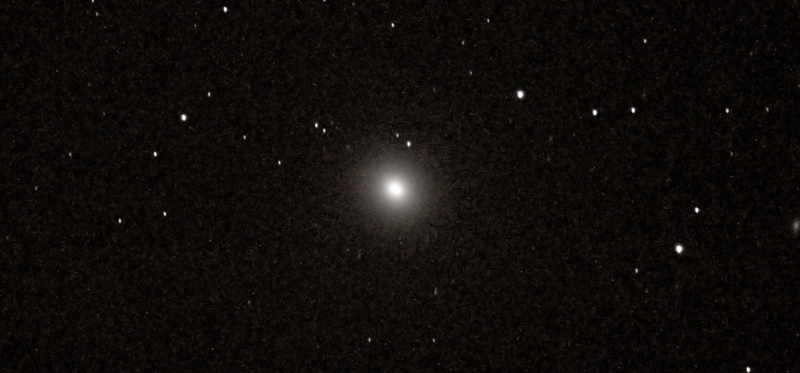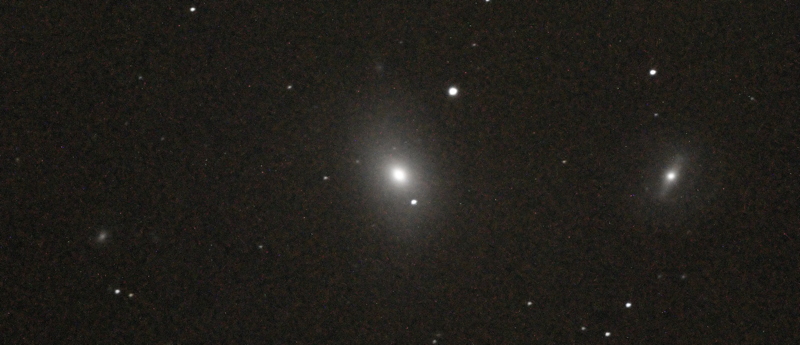Imaging Companion, D7200 DSLR Messier Galaxy Imaging
Posted: 19 April 2015
|
Open: Saturday, 18 April 2015, 1906 MST Temperature: 74°F |
Session: 811 Conditions: Clear, slightly dusty sky |
A new friend who was visiting Tucson came to Cassiopeia Observatory to do some Deep Sky Object imaging using his 8" Celestron HyperStar telescope:

My plan for this night was to image several Messier Catalog galaxies for my Messier Astrophotography Album. 1919 MST: while John was continued to set up his equipment, I viewed Venus, 83X, then Jupiter, 83X and 222X. Three moons were visible at Jupiter. 2019 MST: the Zodiacal Light was nicely visible. I could see it nearly all the way to Castor and Pollux, about 80° elevation.
2035 MST: viewed the following galaxies, 83X, in preparation to image them with the D7200 DSLR (using JPEG, since the Raw converter was not yet available for this new camera): M84, M85, M86. I then slewed to the star Arcturus, mounted the D7200 DSLR at prime focus + extension + off-axis guider, and did a focus test image using the Bahtinov Mask on the 8" LX200-ACF.
Slewed to M84 (galaxy); it was visible centered in the camera viewfinder. And in a rather unique occurrence, a good guide star was nearly centered in the illuminated reticle guiding eyepiece! This is a 5 minute, ISO 5000, guided exposure of M84:

This guided 10 minute, ISO 6400, exposure shows the galaxies M86 (center), NGC4388 (left), and PGC40659 (just left and below M86):

Next was M85. This guided 5 minute, ISO 5000, exposure shows M85 (center), NGC4394 (right), and IC3292 (left):

This is a 10 minute, ISO 6400, guided exposure of M88:

M98, guided 10 minute, ISO 5000:

2314 MST: I took a short break from imaging and sat on the observatory patio, enjoying the view of the night sky from my dark site, and chatted some with John. 2328 MST: went back inside the observatory and resumed DSO imaging.
M91, guided 10 minute, ISO 6400:

And my best image of the night, M99, guided 5 minutes, ISO 6400:

My final DSO imaging target was M104 (Sombrero Galaxy). I did several 30 second exposure framing test images while trying to locate a guide star. I never found one. Rather than rotating the off-axis guider and possibly needing to redo the focus, I decided to just try a 1 minute unguided exposure at various ISO settings. I would go for a longer exposure on the next session. This is an unguided, 1 minute, ISO 12800, exposure:

All of the above images were processed in Aperture, Neat Image (to reduce digital noise in the original JPEG images), and GraphicConverter, and are cropped from the full-frame images.
0058 MST: ended DSO imaging. Removed the camera from the telescope and at 0115 MST, viewed Saturn, 83X and 222X. Four moons were visible: Titan, Rhea, Dione, and Tethys.
0148 MST: viewed M63 (Sunflower Galaxy), M83, and M102 galaxies, 83X. These galaxies will be imaged on the next session.
0213 MST: final look at Saturn, 83X.
It was enjoyable having a fellow amateur astronomer join me for this long night at Cassiopeia Observatory. John, I hope you got some great images.
|
Close: Sunday, 19 April 2015, 0246 MST Temperature: 55°F |
|
I have posted my review of NightCap Pro v6, which is an amazing iOS app for astrophotography. If you have an iPhone, check it out.
Comments are welcome using Email. If you are on Twitter you can use the button below to tweet this report to your followers. Thanks.
Cassiopeia Observatory Home Page
Copyright ©2015 Michael L. Weasner / mweasner@me.com
URL = http://www.weasner.com/co/Reports/2015/04/19/index.html
